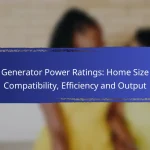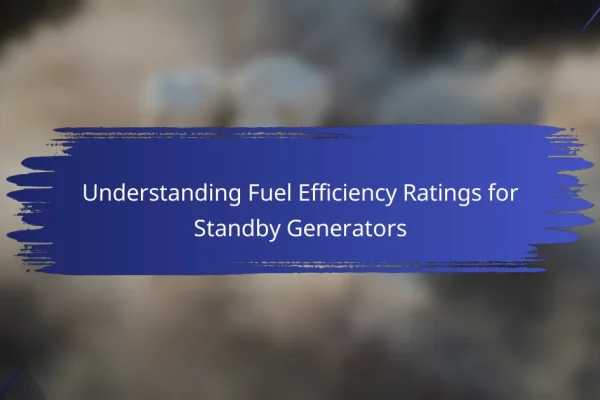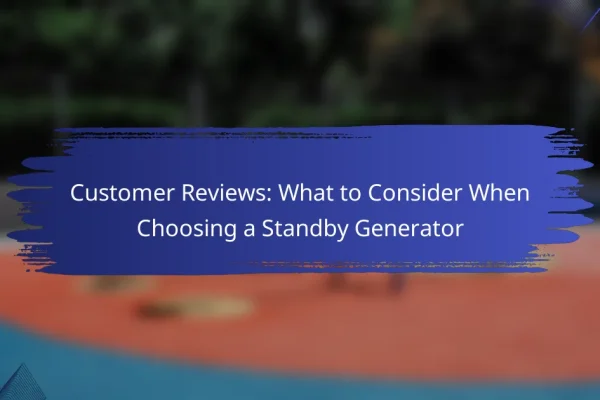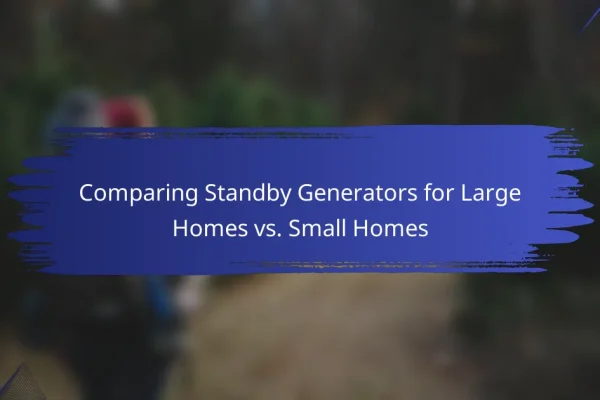What are the best standby generators for residential use?
The best standby generators for residential use provide reliable power during outages, ensuring your home remains functional. Key considerations include power output, fuel type, noise level, and installation requirements.
Generac Guardian Series
The Generac Guardian Series is known for its robust performance and user-friendly features. These generators typically range from 9 kW to 24 kW, making them suitable for various home sizes and power needs.
One of the standout features is the Mobile Link app, which allows homeowners to monitor their generator’s status remotely. Additionally, Generac’s True Power Technology ensures clean power for sensitive electronics.
Briggs & Stratton 40445
The Briggs & Stratton 40445 is a compact standby generator that offers a balance of power and efficiency. With a capacity of 8 kW, it is ideal for smaller homes or essential circuits.
This model is equipped with a durable aluminum enclosure, providing protection against the elements. It also features a user-friendly control panel for easy operation and maintenance.
Cummins QuietConnect Series
The Cummins QuietConnect Series is designed for quiet operation, making it a great choice for residential areas. These generators range from 13 kW to 20 kW, suitable for powering larger homes.
Notable for its sound-dampening technology, the QuietConnect operates at a lower noise level compared to many competitors. It also includes an automatic transfer switch, ensuring seamless power restoration during outages.
How do I choose the right size for a standby generator?
Choosing the right size for a standby generator involves calculating your total wattage needs and understanding the difference between starting and running watts. This ensures that your generator can handle the power demands of your home during an outage.
Calculate total wattage needs
To determine your total wattage needs, list all the appliances and systems you want to power during an outage, such as refrigerators, heating systems, and lights. Add up their wattage ratings, which can usually be found on the appliance labels or in the user manuals.
A good rule of thumb is to aim for a generator that can provide at least 20% more wattage than your total calculated needs. This buffer helps accommodate any unexpected power surges when appliances start up.
Consider starting vs running watts
Understanding the difference between starting and running watts is crucial when selecting a generator. Starting watts are the extra power needed to start appliances, while running watts are the power required to keep them running. For example, a refrigerator may need 800 watts to run but require 1,200 watts to start.
When calculating your generator size, ensure that it can handle the highest starting wattage among your selected appliances. This will prevent overloading the generator when multiple devices are turned on simultaneously.
What features should I look for in a standby generator?
When choosing a standby generator, focus on key features such as an automatic transfer switch, noise level ratings, and fuel type options. These elements significantly impact performance, convenience, and suitability for your specific needs.
Automatic transfer switch
An automatic transfer switch (ATS) is essential for seamless operation during power outages. It detects when the main power supply fails and automatically switches to the generator, ensuring your home remains powered without manual intervention.
When selecting a generator, ensure it comes with a compatible ATS that can handle your power requirements. Look for models that support quick switching, ideally within seconds, to minimize disruption during outages.
Noise level ratings
Noise level is a critical factor, especially if you live in a residential area. Standby generators are typically rated in decibels (dB), and quieter models usually range from 50 to 70 dB, similar to normal conversation levels.
Consider your local noise regulations and the generator’s placement. If noise is a concern, look for generators with soundproof enclosures or those designed for quieter operation to avoid disturbing your neighbors.
Fuel type options
Standby generators can run on various fuel types, including gasoline, propane, and natural gas. Each fuel type has its advantages; for instance, natural gas is often more convenient and requires less storage space, while propane can provide longer run times.
Evaluate your fuel availability and costs in your area when choosing a generator. Some models offer dual-fuel capabilities, allowing you to switch between fuel types based on availability and price fluctuations, providing flexibility and efficiency.
What are the installation requirements for standby generators in the USA?
Installing a standby generator in the USA requires adherence to specific local regulations and standards. Key considerations include local building codes, proper placement, and professional installation to ensure safety and compliance.
Local building codes
Local building codes dictate the standards for installing standby generators, including zoning laws, noise restrictions, and fuel storage regulations. These codes can vary significantly by state and municipality, so it’s essential to check with local authorities before installation.
For example, some areas may require a certain distance between the generator and property lines or structures, while others may have specific guidelines for exhaust placement. Always obtain the necessary permits to avoid fines or complications.
Professional installation recommendations
Hiring a licensed electrician or a certified generator installer is crucial for ensuring that your standby generator is installed correctly and safely. Professionals are familiar with local codes and can help navigate the permitting process.
Additionally, a professional installation typically includes proper sizing of the generator based on your power needs, ensuring that the electrical connections are safe, and performing necessary tests to confirm functionality. Avoid DIY installations, as improper setup can lead to safety hazards and void warranties.
How much does a standby generator cost?
The cost of a standby generator typically ranges from a few thousand to over ten thousand dollars, depending on the size, brand, and features. It’s essential to consider both the purchase price and the installation costs when budgeting for a standby generator.
Average price range for residential models
Residential standby generators generally fall within the price range of $3,000 to $7,500. Smaller units may start around $3,000, while larger, more powerful models can exceed $7,500. Factors influencing the price include wattage capacity, fuel type, and additional features like automatic transfer switches.
Installation costs and considerations
Installation costs for standby generators can vary widely, typically ranging from $500 to $2,500. This variation depends on factors such as local labor rates, the complexity of the installation, and any necessary permits. It’s advisable to obtain multiple quotes from licensed electricians to ensure a fair price.
Considerations during installation include the generator’s placement, fuel supply (natural gas or propane), and compliance with local building codes. Proper installation is crucial for safety and efficiency, so hiring a qualified professional is recommended to avoid common pitfalls. Make sure to check local regulations regarding generator installations to ensure compliance.
What are the maintenance requirements for standby generators?
Standby generators require regular maintenance to ensure optimal performance and longevity. Key maintenance tasks include oil changes and battery upkeep, which help prevent issues during power outages.
Regular oil changes
Changing the oil in your standby generator is crucial for maintaining engine health. It is generally recommended to change the oil every 100 to 150 hours of operation or at least once a year, whichever comes first. Using high-quality oil that meets the manufacturer’s specifications can enhance engine efficiency.
To perform an oil change, first, ensure the generator is off and cool. Drain the old oil, replace the oil filter if applicable, and refill with fresh oil. Regular checks of the oil level can help you catch potential problems early.
Battery maintenance
Battery maintenance is essential for ensuring your standby generator starts when needed. Check the battery’s charge level regularly, ideally every month, and keep the terminals clean and free of corrosion. A well-maintained battery can last several years, but neglect can lead to premature failure.
Consider using a battery maintainer or trickle charger to keep the battery charged during long periods of inactivity. If the battery shows signs of wear or fails to hold a charge, replace it promptly to avoid being left without power during an outage.
How do standby generators compare to portable generators?
Standby generators are permanently installed systems that automatically provide power during outages, while portable generators are movable units that require manual setup. The key difference lies in their functionality, power capacity, and convenience during emergencies.
Power output differences
Standby generators typically offer higher power output compared to portable generators, making them suitable for powering entire homes or businesses. Most standby models can deliver between 7,000 to 20,000 watts, while portable generators usually range from 1,000 to 7,500 watts. This significant difference means standby generators can support essential appliances and systems, such as heating, cooling, and refrigeration, simultaneously.
When selecting a generator, consider your power needs. Calculate the wattage required for critical devices to ensure the generator can handle the load without overloading.
Cost comparison
Standby generators generally have a higher upfront cost than portable generators, often ranging from $2,000 to $10,000, including installation. In contrast, portable generators can be purchased for as little as $500 to $3,000. However, the long-term value of standby generators may justify the initial expense, as they provide seamless power during outages without the need for manual intervention.
Additionally, consider ongoing costs such as maintenance and fuel. Standby generators may require professional servicing, while portable units can often be maintained by the owner. Weigh these factors against your budget and power reliability needs to make an informed decision.











